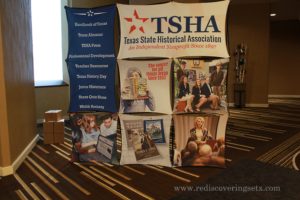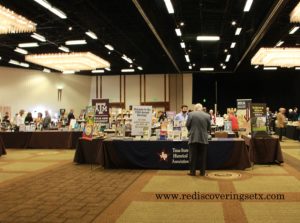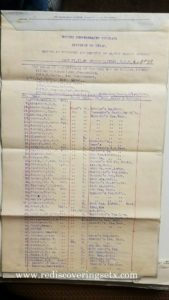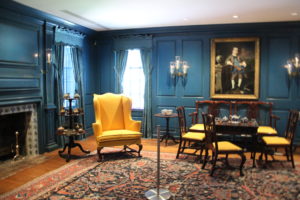 The Texas State Historical Association Annual Meeting 2017 was held last weekend, and I, for one, had a pretty good time. Although Houston traffic was its usual self, I managed to arrive intact for both Friday’s and Saturday’s sessions. I’ve only attended a few of these conferences, but I will say that each year seems to bring a few interesting subjects to light that pique my interest, and this year was no different.
The Texas State Historical Association Annual Meeting 2017 was held last weekend, and I, for one, had a pretty good time. Although Houston traffic was its usual self, I managed to arrive intact for both Friday’s and Saturday’s sessions. I’ve only attended a few of these conferences, but I will say that each year seems to bring a few interesting subjects to light that pique my interest, and this year was no different. 
On Friday, after registration, I perused the exhibitors, vendors, and the silent auction, hoping to find certain publications, documents, or memorabilia pertaining to some of my interests. I did find a few books, but nothing to brag about, unfortunately. I will say that most exhibitors were focused on Texas history, and not really on SETX history, except for a few postcards, reprinted maps, and other documents. As for the documents, I did see two notable ones at a vendor’s table; fellow researcher and JCHC member Bruce A. Hamilton had already purchased the first. He found the original roster of the Albert Sidney Johnson Camp #75 of the United Confederate Veterans, dated 1895. I also saw a Sabine Stock document for sale, but I wasn’t prepared to shell out $4750 for it – nor was anyone else, for that matter.
 One of the best sessions of the day, for me at least, was Using Oral History to Document Rural Dispersed Communities, sponsored by the Texas Oral History Association. This subject has been a very popular topic at the JCHC the past few years, and I can’t stress enough the importance of documenting history straight from the sources of our past. It really doesn’t matter how glorious a life someone has lived, or how simple their means. It is better to ask the questions now than to have someone like me, years from now, examine the facts but fail to generate the “human factor,” of the life they’ve lived. In other words, I can give you the facts, but I can’t give you their story through their own eyes.
One of the best sessions of the day, for me at least, was Using Oral History to Document Rural Dispersed Communities, sponsored by the Texas Oral History Association. This subject has been a very popular topic at the JCHC the past few years, and I can’t stress enough the importance of documenting history straight from the sources of our past. It really doesn’t matter how glorious a life someone has lived, or how simple their means. It is better to ask the questions now than to have someone like me, years from now, examine the facts but fail to generate the “human factor,” of the life they’ve lived. In other words, I can give you the facts, but I can’t give you their story through their own eyes.
On Saturday, I knew which late session I would be attending, but had no clue about which early session to choose. Since I wasn’t alone on this voyage into Texas history, a friend suggested A Tale of Two Bayous: Preservation and Conservation in Houston. This seemed like a good topic, and it was. Both speakers were excellent, and their stories were fascinating. I especially enjoyed Nathan Jones’ presentation on Ima Hogg and her architect, Wayne Bell, during the session Building the Decorative Arts Collection of Ima Hogg, since I have visited the property multiple times. For those who haven’t yet visited Bayou Bend, you are missing out on a wonderful tour. There is much to see, and it was surprising to hear the explanation of how collection came to be.
The last session, and the one I most wanted to attend, was History in Action: The College Classroom in 2017. I initially wanted to go to this because I saw that someone had done a paper on William P. Hobby. Hobby is an interest of mine, because of my research into Florence Stratton. I was amazed by the talk and pleased to learn a few things from speaker Hector Zuniga that I did not know about the former Texas governor. To me, this talk alone was worth the trip.
Looking back on the conference, I can say that I took away some new knowledge of how to use oral history, and I am looking forward to meeting a cast of young scholars who do their homework and churn out some great historical research papers. I hope the trend continues.

You must be logged in to post a comment.